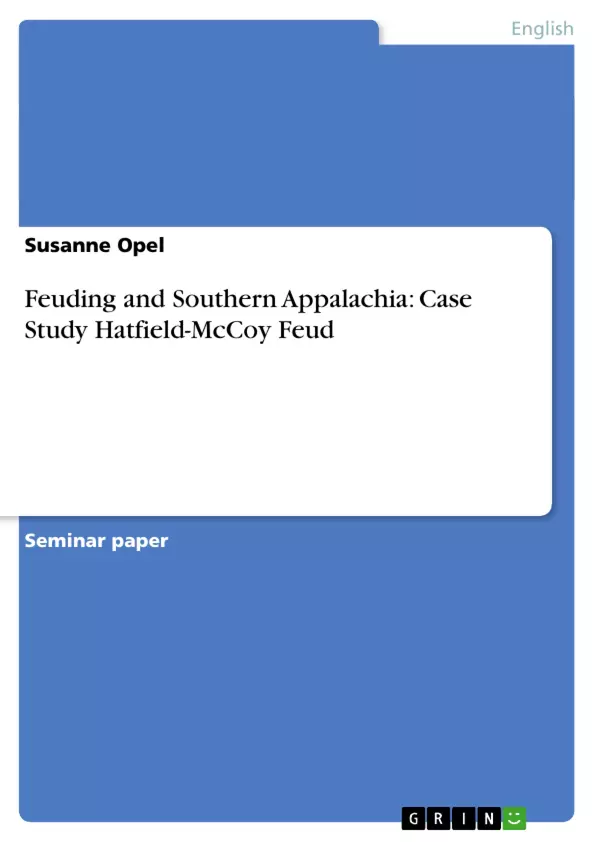The American South is generally known for its hot climates, its cotton and tobacco fields and its slave-holding history. However, for the region of Southern Appalachia, it is a different story. Life in the mountains was quite different from our picture of the South. The people lived on small farms, miles away from each other and owned only little land on which they worked with their whole family and some helpers but normally without slaves.
Since the mountaineers lived so isolated they developed their own traditions and sets of values and became distinct from the ordinary Southerner. Of course that constructed stereotypes. The Appalachian mountaineer, or “hillbilly” is seen as illiterate, dumb, naïve, slow, ugly, dirty, lazy, drunken, violent and all in all “weird”. Also, the role of the family is important: mountaineers are said to have dozens of children and a whole community of hundreds of people may bear only three different surnames. Thus, kin is important in the mountains and family loyalty may be essential.
On grounds of these and other stereotypes and several incidents, happening mainly at the end of the 19th century, a myth about mountain feuding emerged. According to the media of those times and countless stories and legends developing from them, mountaineers start to quarrel about some non-important things and this produces a conflict between their families, which lasts over decades. As Mark Twain, one of the best known writers on mountain feuding lets Buck Grangerford, a character in his novel The adventures of Huckleberry Finn, say:
“[…] a feud is this way. A man has a quarrel with another man, and kills him; then that other man´s brother kills him; then the other brothers, on both sides, goes for one another; then the cousins chip in – and by-and-by everybody´s killed off, and there ain´t no more feud. But it´s kind of slow, and takes a long time.”
Inhaltsverzeichnis (Table of Contents)
- I. Feuding - a popular pastime among mountaineers?
- II. The Hatfield-McCoy feud in American culture
- III. The historical facts
- 1. The Tug Valley Community
- 2. The feud leaders
- 2.1. "Devil Anse" Hatfield
- 2.2. "Old Ranel" McCoy
- 2.3. Perry Cline
- 3. The first phase 1878-1882
- 4. Interim
- 5. The second phase 1888-1889
- IV. Relevance of the Hatfield -McCoy myth
Zielsetzung und Themenschwerpunkte (Objectives and Key Themes)
This paper aims to compare the prevalent myths and legends surrounding the Hatfield-McCoy feud with the historical facts. It examines the feud's significance in American culture and explores how stereotypes about mountaineers have shaped our understanding of Southern Appalachia.
- The development of stereotypes about Appalachian mountaineers
- The impact of media coverage on shaping public perception of the Hatfield-McCoy feud
- The distinction between historical facts and fictional representations of the feud
- The role of family loyalty and community dynamics in the feud
- The influence of the Hatfield-McCoy feud on American folklore and popular culture
Zusammenfassung der Kapitel (Chapter Summaries)
- I. Feuding - a popular pastime among mountaineers? This chapter introduces the unique characteristics of Southern Appalachia, contrasting it with the typical image of the American South. It explores stereotypes surrounding Appalachian mountaineers, including their perceived isolation, values, and the importance of family ties. The chapter then introduces the myth of mountain feuding, drawing on Mark Twain's depiction in The Adventures of Huckleberry Finn. It concludes by mentioning the prevalence of feuding in the Appalachian region, particularly highlighting the notorious Hatfield-McCoy feud.
- II. The Hatfield-McCoy feud in American culture This chapter discusses the widespread awareness of the Hatfield-McCoy feud in American culture despite its limited representation in historical texts. It explores the enduring influence of the feud on popular culture, citing examples such as tourist attractions, media depictions, and artistic works. This chapter highlights the difference between the historical feud and the often exaggerated and romanticized fictional versions.
- III. The historical facts This chapter delves into the historical context of the Hatfield-McCoy feud, focusing on the community, key figures, and the timeline of events. It provides biographical details of "Devil Anse" Hatfield, "Old Ranel" McCoy, and Perry Cline, highlighting their roles in the escalating conflict. The chapter examines the first phase of the feud from 1878-1882, followed by a discussion of the interim period and the second phase from 1888-1889.
Schlüsselwörter (Keywords)
Southern Appalachia, mountain feuding, Hatfield-McCoy feud, stereotypes, historical facts, folklore, popular culture, American culture, family loyalty, community dynamics, media coverage.
- Citation du texte
- Susanne Opel (Auteur), 2003, Feuding and Southern Appalachia: Case Study Hatfield-McCoy Feud, Munich, GRIN Verlag, https://www.grin.com/document/42609



